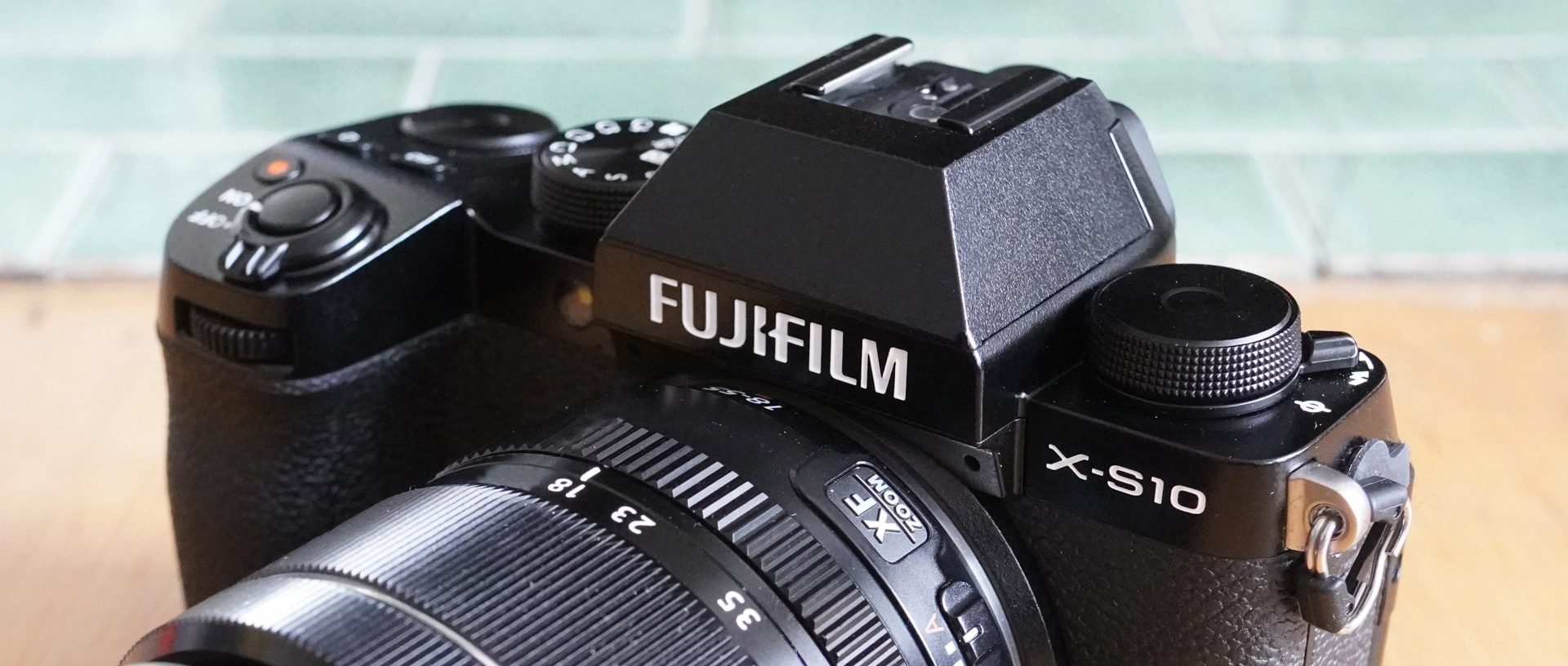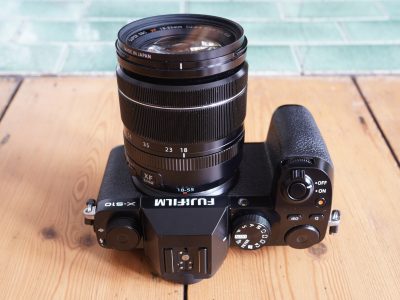Fujifilm XS10 review so far
-
-
Written by Gordon Laing
The Fujifilm X-S10 is a mid-range mirrorless camera with a 26 Megapixel APSC sensor, uncropped 4k video, a fully-articulated touch-screen and built-in stabilisation. Announced in October 2020, the X-S10 debuts a new branch in the X-system with a departure from the company’s retro-styled exposure controls for the more modern PASM mode selection used by most of the competition along with the entry-level X-series models.
But don’t be fooled into thinking the X-S10 is in any way basic as it shares the core features of the X-T30 while adding a bigger grip, side-hinged screen, longer 4k recording times and impressively becoming Fujifilm’s smallest and most affordable camera to squeeze in built-in stabilisation, or IBIS for short. In fact in many respects the X-S10 is closer to a baby X-T4, packing much of the flagship into a smaller, lighter and more approachable body that at $999 or 949 pounds is roughly two thirds the price and only around 100 bucks more than the X-T30. Fujifilm let me try out a pre-production model for a few days and in my first-looks video below I’ll show you why the X-S10 could be the X-camera you’ve been waiting for. If you prefer to read a written version of the highlights, keep scrolling!
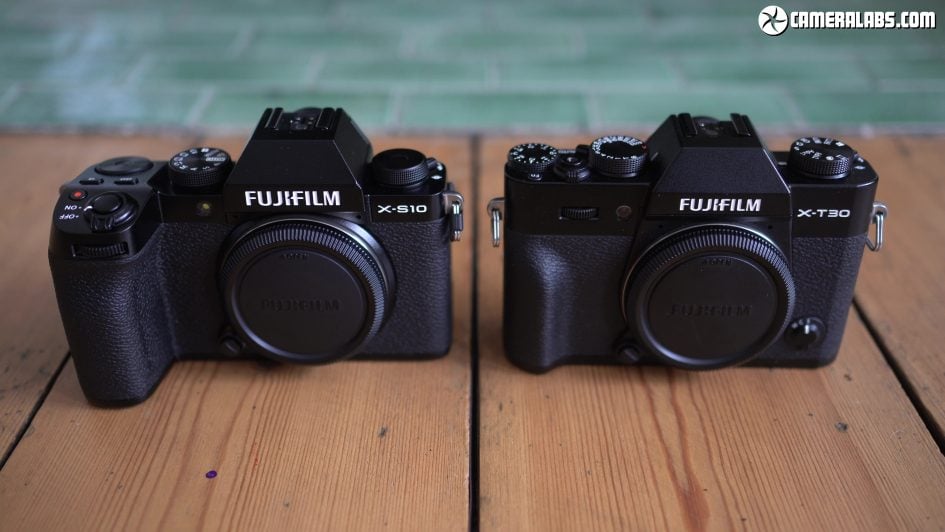
Above: Here’s the new X-S10 on the left joined on the right by the older X-T30 which is arguably the closest model in the series. The X-S10 is a little taller and wider than the X-T30, although their main body thickness is very similar. The most obvious difference though is the considerably more substantial grip of the X-S10, allowing the battery to relocate and free up room inside for the IBIS system, while also giving you much more to hold onto.
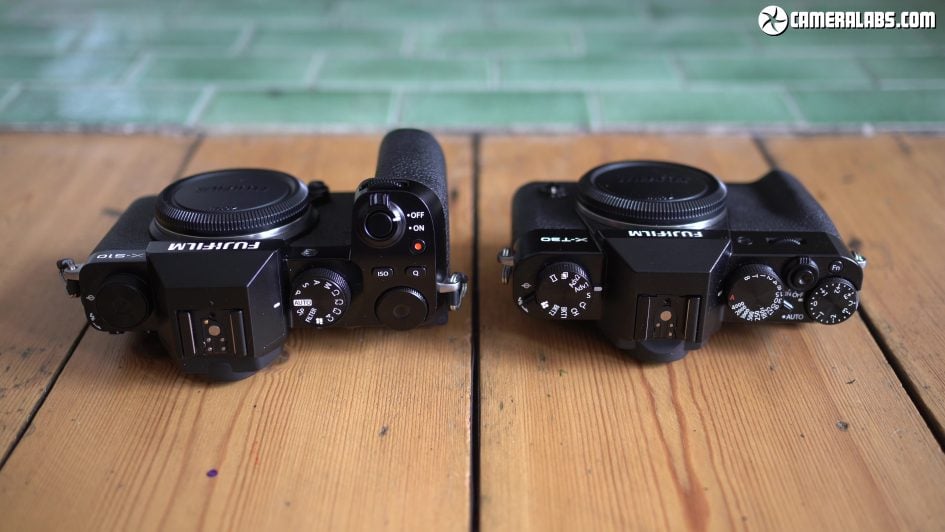
Above: Viewed from the top the different profiles and grips become more obvious, as do the different approaches to controls. The X-T30 employs the dedicated shutter speed dial of most higher-end Fujifilm bodies, as well as dials dedicated to exposure compensation and drive modes. Also note the small shutter release button, threaded for a mechanical cable release and the flash pins on the hotshoe too which I’ll talk about in a moment. The overall aesthetic of the classic Fujifilm style is all about direct control and retro style, but while some love the wealth of numbers on the dials, they can prove less approachable to others, even intimidating to some. So the new X-S10 has opted for the mode-based approach of most rivals and some simpler models in the range, with a mode dial, joined by a finger and thumb dial on the right and a customisable dial on the left. Notice the larger shutter release button, now positioned further forward on the grip, which falls more comfortably under your finger than the X-T30, although I found the sloping power collar lacked purchase and was harder to turn.
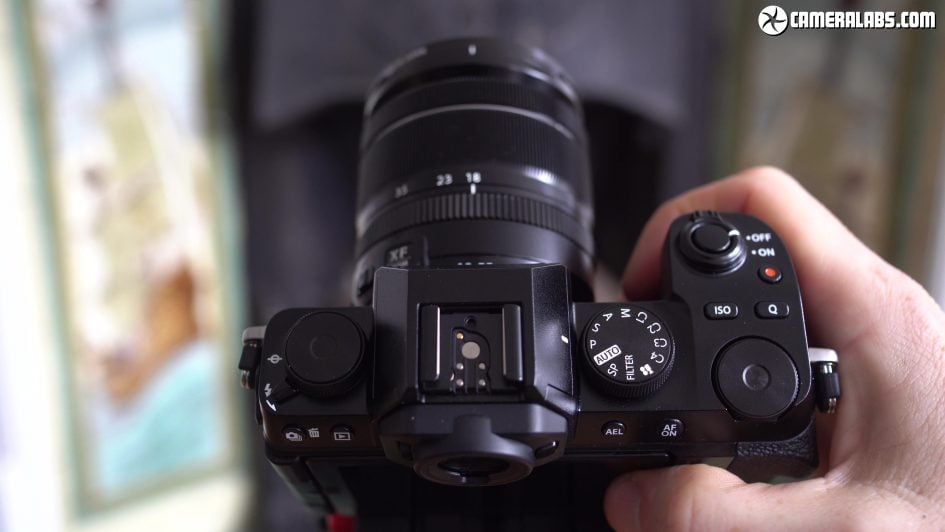
Above: The movie record, ISO and Quick-menu buttons on the top surface all work as labelled by default, but, along with the function, AE Lock and AF On buttons to the right of the viewfinder, can be customised to operate any of 60 different settings across eight pages.
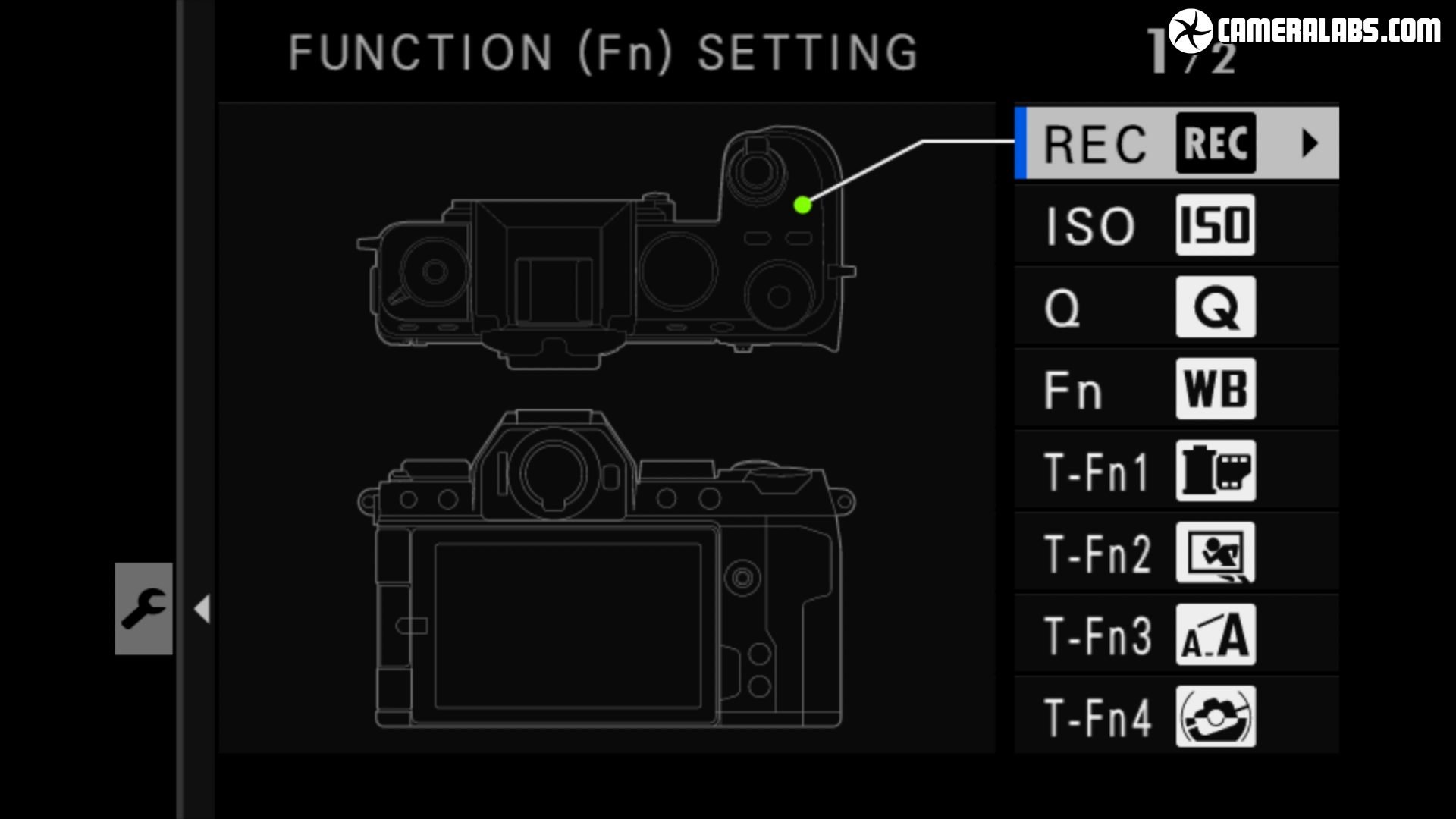
Above: The upper left control dial can also be customised and while traditionalists may assign it to exposure compensation straightaway, I enjoyed the default setting where it scrolls through the Film Simulations which apply Fujifilm’s famous colour and tone styles.
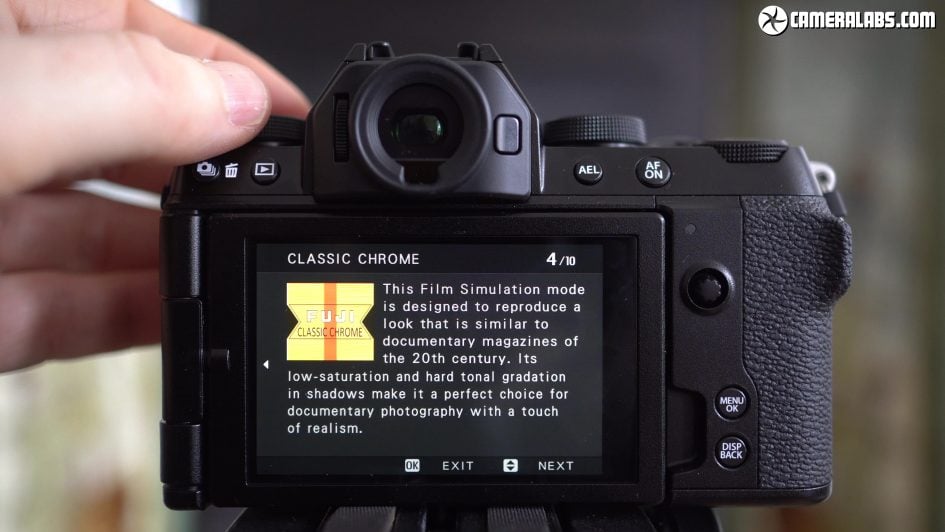
Above: In fact it’s worth taking a quick break from the design to check out the new user interface for the Film Simulations which is not only more colourful to start with, but offers optional information describing each profile and how you might use it. I’m very fond of Fujifilm’s Film Simulations and how they let me achieve most of the effects I’m after in-camera. I’m particularly fond of Velvia for highly saturated subjects, Classic Chrome or Classic Negative for a moody retro style or Acros for high contrast black and white. You’ll find the full set here including the latest Eterna Bleach Bypass for those zombie apocalypse shots, along with the monochrome adjustments, grain and colour chrome effects. It’s also worth mentioning the full Auto exposure mode can now access a new Auto Film Simulation option that can choose between a handful of profiles as well as deploying Colour Chrome effects. Also remember if you shoot in RAW, you can create new versions of your photos in playback with different Film Simulations – I love doing this to try out different profiles on the same image.
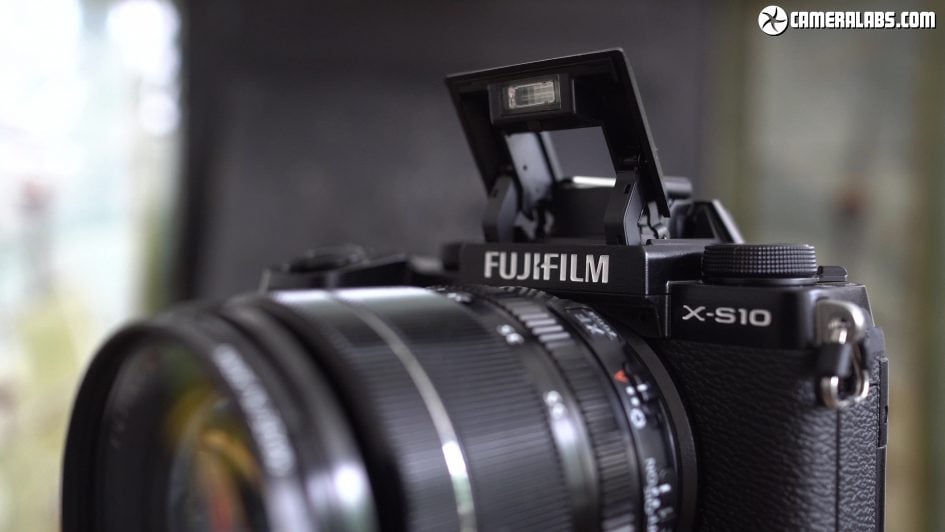
Above: I mentioned the flash pins earlier and notice how the X-S10, or at least my pre-production sample, has five small pins compared to three on the X-T30. You’ll generally find these on higher-end Fujifilm bodies to support unpowered flash accessories. I’m not sure why this was included here though since the X-S10, like the X-T30, includes a small popup flash triggered by a collar switch on the custom control dial.
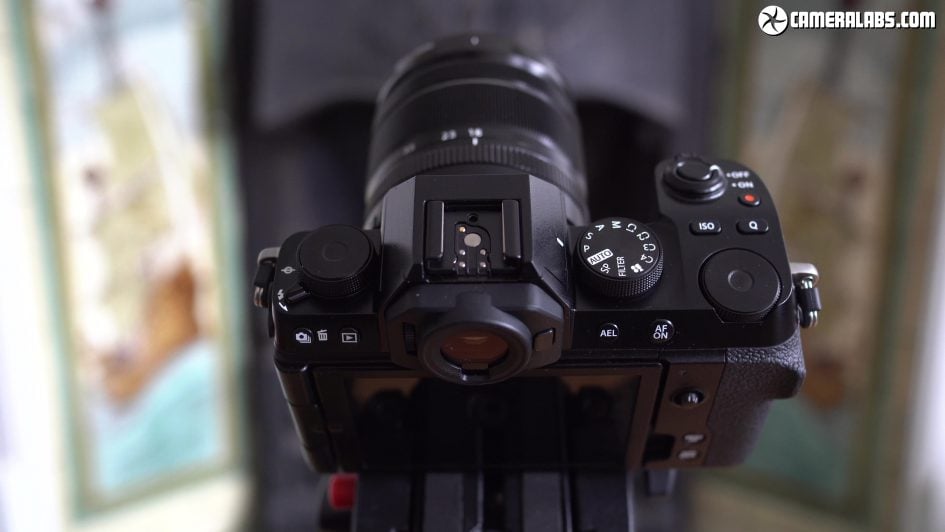
Above: While loyal Fuji-fans will miss the retro aesthetic, there’s no denying it’s very easy to get shooting with the X-S10 and even though I personally prefer the look of the X-T30 and X-T4, I have to admit I generally set their shutter dials to A or T, effectively turning them into mode-based models. Between the three control dials, wealth of customisable buttons, AF joystick and practical touch-screen, it’s possible to setup the X-S10 exactly how you want it, and I love that you can still keep doubling the shutter speed beyond the usual arbitrary limit of 30 seconds to as long as 15 minutes before having to resort to Bulb. Fujifilm’s also learned from the poorly-positioned Q-menu button on the X-T30 which proved easy to touch by mistake, and relocated it sensibly to the top surface. Indeed beyond the reduced purchase of the power collar, my only real physical complaint is that like the X-T30, the X-S10 is not officially weather-sealed, a downside compared to the Sony A6400 and A6600 at least in theory. That said, I’ve never experienced any issues shooting with the X-T30 in a wide variety of conditions.
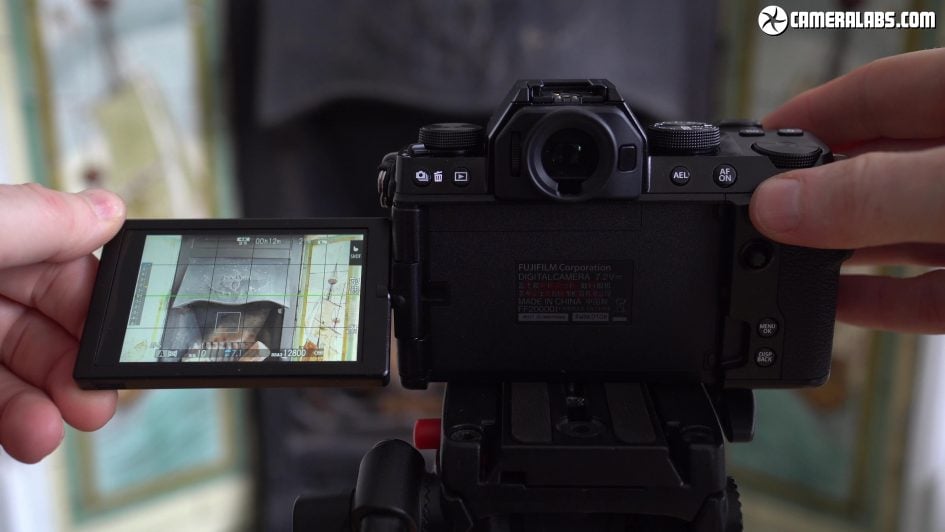
Above: In a move that will delight anyone who needs to film or photograph themselves, the X-S10 employs a side-hinged, fully-articulated screen – in fact only the second Fujifilm to do so after the X-T4. Fujifilm has explored more screen articulation options than most, and while everyone has their preferred style, mine remains a side-hinge, not just for filming, but also composing comfortably at high or low angles in landscape or portrait orientations – and remember Fujifilm considerately rotates the shooting info in portrait too, at least for stills.
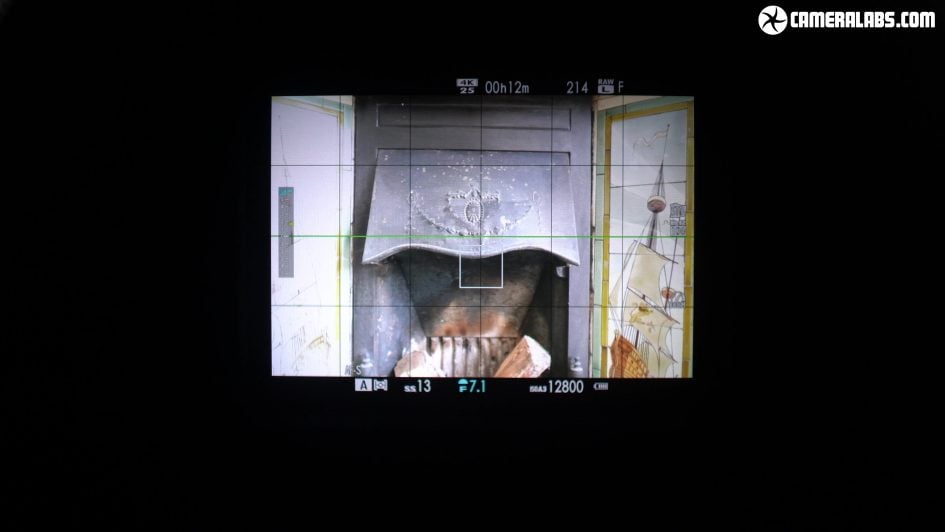
Above: The X-S10 inherits the 2.36 million dot OLED viewfinder of the X-T30 with its 0.62x magnification. The resolution is comparable to rivals at this price, but the magnification a bit smaller. The viewfinder on the Sony A6400 delivers a bigger image with 0.7x magnification, and this is also a differentiator with the higher-end X-T4 who’s viewfinder is larger still at 0.75x and more detailed too with 3.69 million dots. The X-S10 can drive its EVF at 100fps if desired.
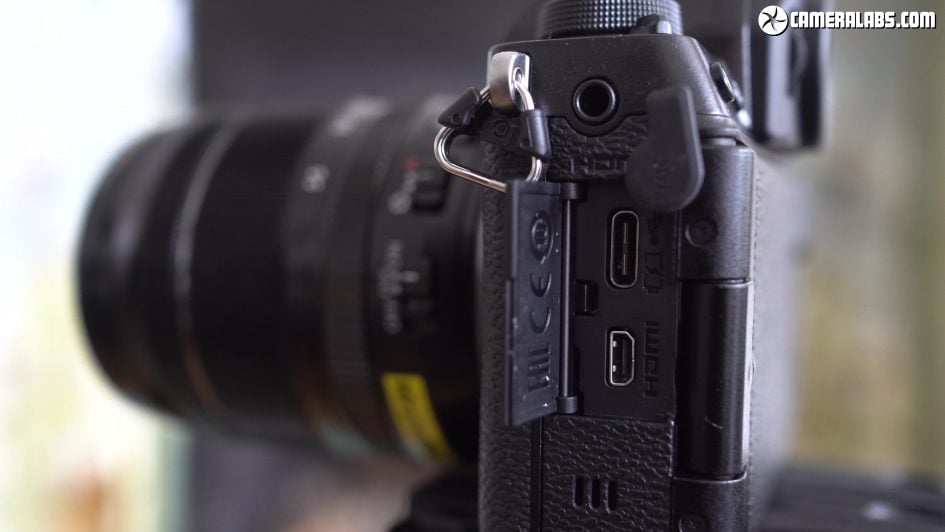
Above: Behind a flap on the left side you’ll find USB-C and Micro HDMI ports, while a standard 3.5mm mic input is positioned higher to clear the screen – yes, finally a departure from the annoying 2.5mm jacks of many earlier models. Like the X-T30, but unlike most rivals at this price, the HDMI can output 10 bit 4:2:2 to an external recorder, while the USB-C port supports both in-camera charging and power over USB so you could use a powerbank to keep the camera running. Like some earlier Fujifilm cameras, you can also use the USB-C port as a headphone jack and Fujifilm considerately includes a compatible adapter in the box. The X-S10 also becomes the first mid-ranger in the series to work as a webcam over USB.
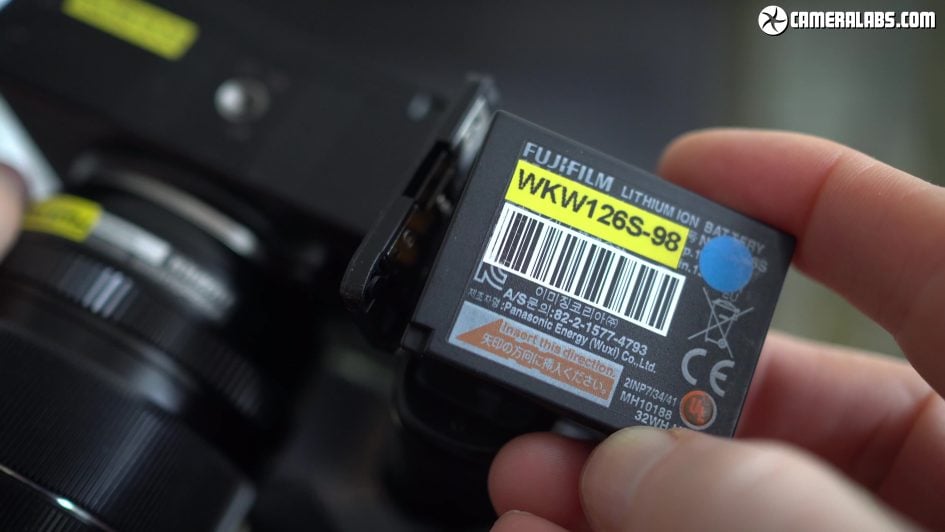
Above: The X-S10 is powered by the same small battery as the X-T30, good here for a claimed 400 shots; for video, I managed an hour’s worth of 4k per charge. The bigger news is its relocation into the grip – along with a tripod thread that’s closer to the optical axis – means you’ll be able to more easily access the battery compartment without removing most tripod plates. Like the X-T30, the single SD card slot is housed alongside the battery and remains unable to exploit the speed of UHS-II cards. If you want faster or dual slots, it’s the single-digital X-T or X-Pro for you.
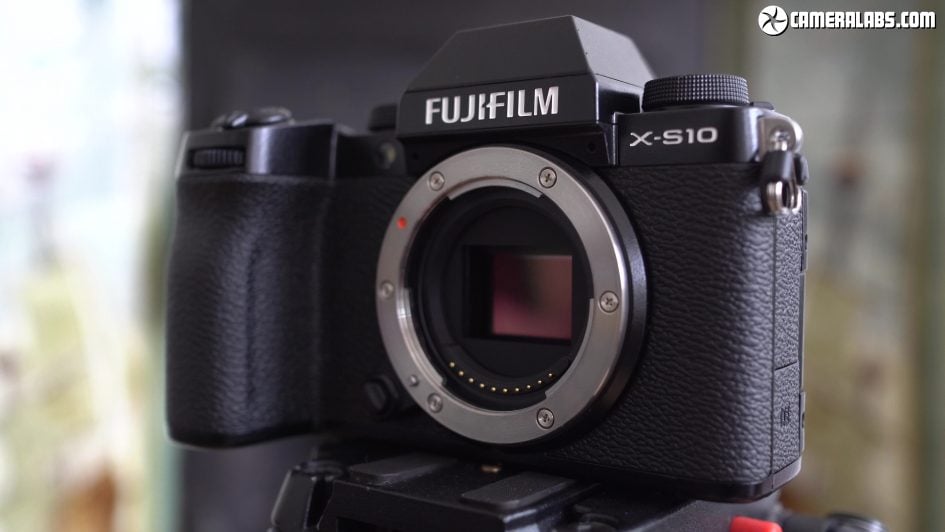
Above: As a member of the X-series, the X-S10 can of course use any X-mount lens with 35 to choose from at the time of writing. Fujifilm has embraced the APSC format for mirrorless more than Sony or Canon, and it shows in the native lens selection. Meanwhile the X-Trans IV sensor may now be two years old, having made its debut on the X-T3, but remains Fujifilm’s best to date and coupled here with the X-Processor IV, so you’re getting the same photo quality as the X-T4 and X-Pro 3.
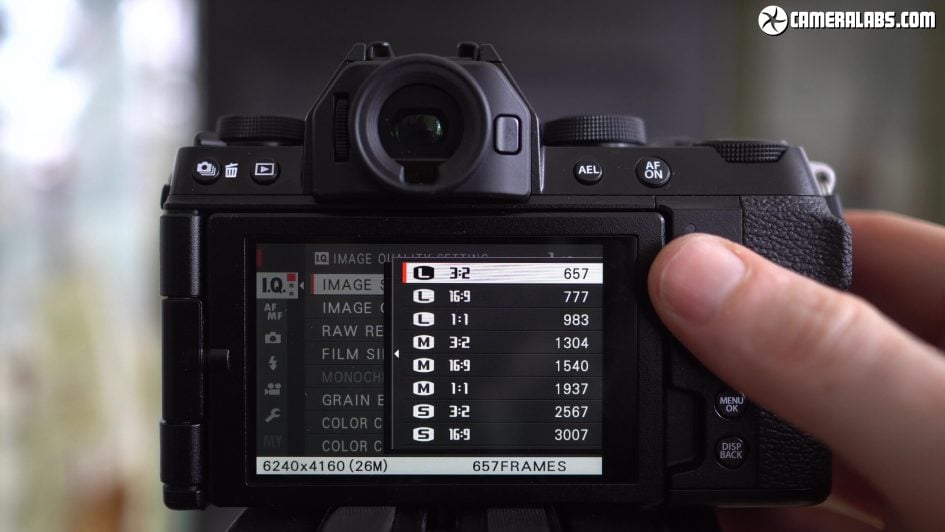
Above: Best quality 26MP images measure 6240×4160 pixels and can be recorded as JPEGs, RAW files or both together; there’s two levels of JPEG compression and the choice of RAW compression too. The X-Trans IV sensor sports embedded phase-detect autofocus across the entire frame and the X-S10 can fire bursts at up to 8fps with the mechanical shutter, or up to 20fps with the silent electronic shutter without cropping; if you’re happy with a small crop, the electronic bursts can speed-up to 30fps, although in all electronic modes beware of skewing due to rolling shutter.
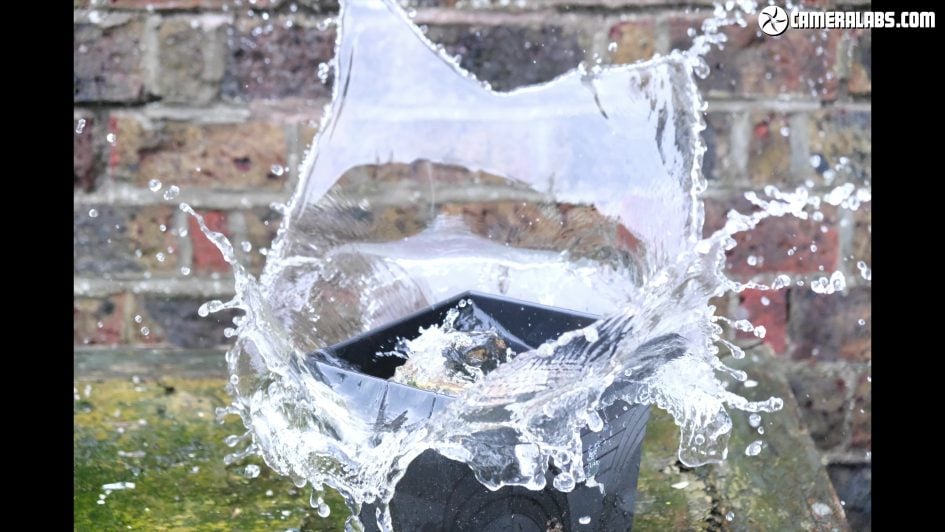
Above: Here’s a frame from burst taken with the fastest mechanical shutter of 8fps. Canon’s M6 II can shoot almost twice as fast, but 8fps is fast enough for most and there’s still the electronic modes.

Above: Here’s another frame from a burst, this time taken with the electronic shutter at 20fps, but also using the pre-burst mode. I actually pushed the shutter down as soon as the block hit the water, but pre-burst buffered a few frames before to ensure I grabbed the moment.
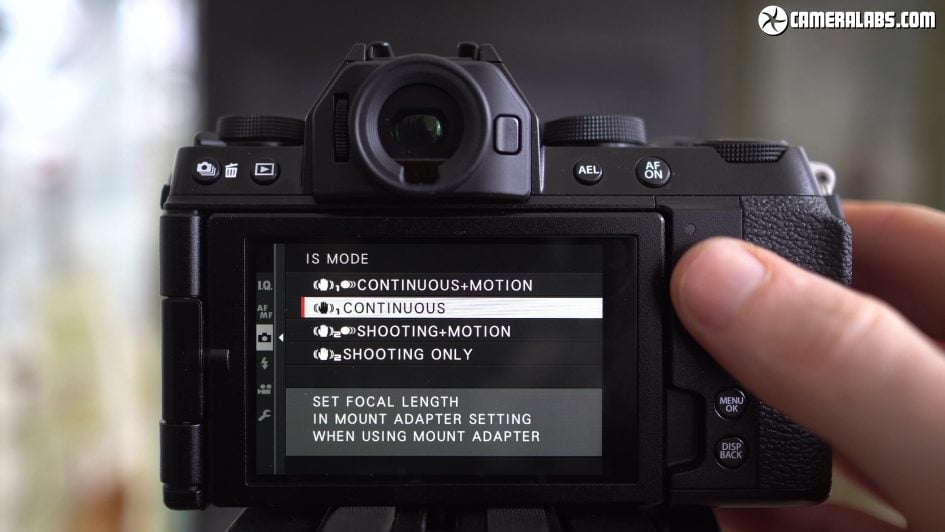
Above: So far so similar to other models in the range, so let’s get on with the big new feature: Fujifilm’s third IBIS unit in the X-series and its most compact yet. It’s a five-axis system that claims up to six stops of compensation depending on the lens, half a stop less than the best claimed by the X-T4, but half a stop better than the best of the X-H1. For me, IBIS is as useful for composing carefully with unstabilised lenses as it is for handholding slower shutters. It really makes lenses like the XF 56, 90 and 16-55mm much more usable.

Above: Here’s a photo I took with the X-S10, although as a pre-production model, I can’t comment further on quality yet. That said, with the same sensor and processor as the most recent generation of higher-end Fujifilm bodies, the image quality is already very well-known. Just look at my X-T3, X-T4, X-T30 and X-Pro 3 reviews for a load of examples.
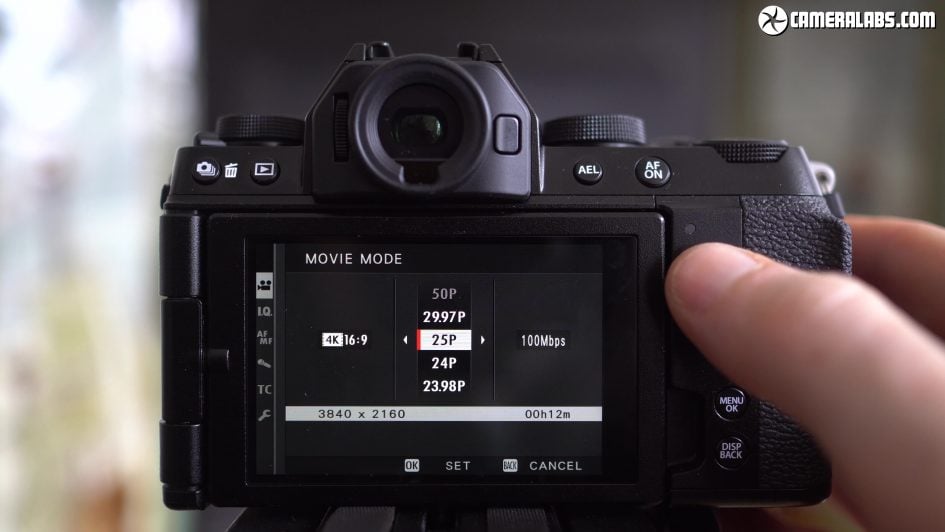
Above: Moving onto video, the X-S10 unsurprisingly inherits the core movie capabilities of the X-T30 with uncropped 4k from 24 to 30p or 1080 up to 60p in UHD or DCI shapes, separate exposure controls for stills and video, the option of internal F-log for grading as well as 10 bit 4:2:2 output over HDMI. The X-S10 does however now allow you to record much more useful half hour clips in 4k, unlike the 10 minute clip limit of the X-T30, and I managed two on a single charge without overheating, plus the mic input and screen articulation are now better-suited for videographers. The big news for video though of course remains IBIS, and I’ve included a bunch of examples and comparisons in my video review at the top of the page where the X-S10 transforms the use of unstabilised lenses for handheld video. IBIS alone is pretty good, but you can also apply additional digital stabilisation which incurs a 1.1x crop, while an optional Boost IS mode provides further steadiness for static compositions.

Above: If you’re into slow motion, the X-S10 can film 1080 at up to 240p and here’s a frame grab from a clip I filmed in 200p for an 8x slowdown on my 25p timeline. Check out my video review for some vlogging examples.
Fujifilm X-S10 verdict so far
The Fujifilm X-S10 represents a new branch in the X-series, delivering the power and quality of the X-T series, but with a more approachable control system. So it’s out with the retro-styled shutter dial and in with a more common PASM mode control which, while lacking vintage charm, may prove easier for first-time Fujifilm owners. Whatever your control preference though, the X-S10’s grip makes it easier to hold than the X-T30 and more practical with a wider range of lenses, while a side-hinged fully-articulated screen provides greater compositional flexibility. Most importantly, the X-S10 becomes the most compact model in the series to sport built-in stabilisation and while Fujifilm reckons the X-T4’s system remains a little better with some lenses, I found the X-S10’s IBIS still transformed the use of unstabilised lenses for photos and video. Videographers will also appreciate the standard mic input, half hour 4k clips and the chance to adapt the USB-C port for headphones. While I personally prefer the look of the X-T30, I found the X-S10 a much more practical and flexible camera to use and would ultimately choose it over that model. The lack of official weather-sealing is the only real downside, but I’ve never experienced issues with the equally unsealed X-T30. Overall the X-S10 is a very strong camera for the money and becomes arguably more compelling than either the Canon M6 II and Sony A6600, and proves there’s plenty of life left in APSC.
Check prices on the Fujifilm X-S10 at B&H, Adorama or WEX! Alternatively get yourself a copy of my In Camera book or treat me to a coffee! Thanks!